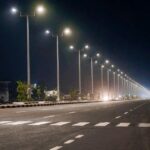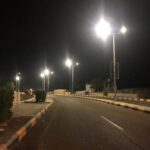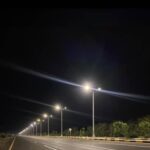In this age of technological advancements and environmental consciousness, finding sustainable ways to illuminate our surroundings has become increasingly important. A Solar light with pole offers a brilliant alternative to traditional lighting systems by harnessing the power of the sun and providing efficient and eco-friendly illumination. These remarkable lighting solutions combine the benefits of solar energy and functional design, making them a perfect choice for various outdoor lighting needs. Let’s explore the fascinating world of solar lights with poles, exploring their advantages, applications, and the remarkable impact they can have on our lives.

The Basics of Solar Light with Pole
Solar light technology harnesses the power of the sun to generate illumination. It consists of various components that work together to provide efficient and sustainable lighting solutions.
What are the components of a solar light with pole?
- Solar Panel: It captures sunlight and converts it into electrical energy. The solar panel contains photovoltaic cells that generate electricity when exposed to sunlight.
- Battery: It stores the electrical energy generated by the solar panel during the day. Typically, lithium-ion or lead-acid batteries are used in solar lights.
- Light Fixture: The light fixture incorporates one or more LED (Light Emitting Diode) bulbs. LEDs are highly efficient and provide bright illumination while consuming minimal energy.
- Pole: The pole serves as a support structure for the solar light system, holding the solar panel, battery, and light fixture at an elevated height. It can be made of materials such as steel, aluminum, or composite materials.
- Controller: It regulates the charging and discharging of the battery. It manages the flow of electricity, ensures optimal operation, and protects the battery from overcharging or deep discharging.
- Sensor and Controls: These sensors can detect ambient light levels or motion, allowing the light to automatically turn on or adjust its brightness when needed.
Advantages of Solar Light with Pole
What are the benefits of these innovative lighting systems?
1. Energy efficiency and sustainability
Traditional lighting systems rely heavily on electricity generated from fossil fuels, leading to significant energy wastage. In contrast, solar light with pole utilizes photovoltaic cells to convert sunlight into electricity. This clean and renewable energy source ensures optimal energy efficiency by directly powering the lights without any transmission or distribution losses. As a result, solar light with pole provides an effective solution to conserve energy and decrease overall electricity consumption.
Furthermore, the sustainability aspect of solar light with pole cannot be overstated. Solar power is a sustainable and environmentally friendly alternative to conventional energy sources. By utilizing solar energy, we can significantly reduce greenhouse gas emissions, air pollution, and dependence on non-renewable resources. Solar light with pole plays a vital role in mitigating climate change and fostering a more sustainable future for our planet.
2. Cost-effectiveness and long-term savings
Other lighting systems rely on electricity from the grid, which can be expensive due to rising energy costs. In contrast, solar light with pole utilizes renewable solar energy, reducing reliance on costly electricity. By harnessing the sun’s rays during the day, these lights can charge their batteries and operate without drawing power from the grid, leading to significant cost savings over time.
Once installed, a solar light with pole requires minimal maintenance and have an extended lifespan. The use of high-quality solar panels and efficient LED technology ensures durability and reliability, minimizing the need for frequent replacements or repairs. Unlike traditional lighting systems that require regular bulb changes and incur ongoing maintenance costs, solar light with pole continues to operate reliably for many years, reducing long-term expenses.
3. Environmental friendliness and reduced carbon footprint
They utilize solar panels to convert sunlight into electrical energy, which is then stored in batteries for later use. This self-sufficient energy generation process eliminates the need for traditional grid electricity, reducing the demand for fossil fuels and decreasing greenhouse gas emissions. The use of solar lights with poles also eliminates the need for trenching and wiring, which are common practices for traditional lighting installations. This not only saves valuable resources but also minimizes disturbances to the natural landscape.
Furthermore, solar lights with poles operate on a clean, renewable energy source – the sun. Unlike fossil fuels, solar power does not release harmful pollutants or greenhouse gases during the energy generation process. By utilizing solar energy, these lights contribute to cleaner air quality, reduced air pollution, and improved public health.
4. Flexibility and easy installation
One of the key advantages of these lights is their versatility. They can be effortlessly mounted on poles, allowing for convenient placement in areas where traditional electrical wiring may be impractical or costly. This flexibility enables the installation of solar lights with poles in remote locations, such as rural areas, parks, parking lots, and pathways, without the need for extensive infrastructure modifications.
The ease of installation is another notable advantage. Solar lights with poles are designed to simplify the setup process, ensuring that both professionals and homeowners can easily install them without requiring specialized knowledge or skills. The entire installation process involves mounting the light fixture on the pole and securing it in place. This straightforward procedure reduces installation time and costs, providing a convenient lighting solution that can be implemented quickly and efficiently.
5. Independence from the power grid
The ability to function independently from the power grid brings numerous advantages. First and foremost, it eliminates the ongoing cost of electricity consumption, as solar lights draw their energy directly from the sun, which is free and abundant. This cost-effectiveness makes solar lights a sustainable and economically viable lighting solution in the long run.
Moreover, independence from the power grid enhances the reliability of lighting in remote or underserved areas. Communities lacking access to reliable electricity can greatly benefit from solar lights, as they provide a consistent and dependable source of illumination.
Factors to Consider when Choosing Solar Light with Pole
Just like everything else, choosing a solar light with pole requires you to consider a few factors such as;
1. Location and sunlight availability
The location of the solar light plays a significant role in determining its overall effectiveness. It is essential to install the light pole in an area that receives ample sunlight throughout the day. Areas with obstructions such as tall buildings, trees, or other structures can cast shadows and limit the amount of sunlight reaching the solar panels. As a result, the light’s ability to generate and store energy may be compromised.
The availability of sunlight directly affects the runtime and brightness of the solar light. Solar lights rely on photovoltaic cells to convert sunlight into electricity, which is then stored in batteries for later use. The more sunlight the solar panels receive, the more energy is generated and stored, resulting in longer operating hours and brighter illumination.
2. Light output and brightness requirements
The light output refers to the total amount of light emitted by the solar light. It determines the illumination level and coverage area provided by the light. A higher light output ensures greater visibility and enhanced safety in outdoor areas.
Brightness requirements, on the other hand, refer to the desired intensity of light needed for specific applications. For example, a solar light installed in a parking lot may require a higher brightness level compared to a light used for decorative purposes in a garden.
Considering these factors is crucial because insufficient light output or brightness can lead to inadequate visibility and compromised safety. On the other hand, excessive light output or brightness may result in wasted energy and unnecessary light pollution.
3. Battery capacity and storage capabilities
A solar light’s battery capacity is measured in terms of ampere-hours (Ah) and indicates the amount of electricity it can store. Higher battery capacity allows the light to accumulate more energy during daylight hours, resulting in longer operational times during the night. A larger battery capacity is especially crucial in areas with limited sunlight or during seasons with reduced daylight hours.
Storage capabilities are equally vital as they dictate how efficiently the solar light harnesses and retains the energy collected. Advanced solar lights employ innovative technologies like maximum power point tracking (MPPT) to optimize energy conversion and maximize charging efficiency. These features ensure that the light captures the maximum amount of energy from the sun and effectively stores it in the battery for later use.
4. Durability and weather resistance
When it comes to durability, a solar light with a robust construction and high-quality materials will be more reliable and long-lasting. Look for lights that feature sturdy poles made from durable metals such as aluminum or stainless steel. These materials are known for their strength and resistance to corrosion, ensuring the pole can withstand exposure to moisture, heat, and other environmental elements.
Weather resistance is another vital consideration. A solar light with pole designed for outdoor use should have adequate protection against water, dust, and other weather-related elements. Look for lights that have an IP (Ingress Protection) rating, which indicates the level of protection against dust and moisture. Higher IP ratings, such as IP65 or IP67, offer better resistance to water and ensure the light can continue operating even during heavy rain or snowfall.
5. Maintenance and warranty options
A solar light with pole requires regular upkeep to ensure optimal performance. This includes inspecting the solar panels for any dirt or debris that may hinder their efficiency. Regular cleaning of the panels can maximize the absorption of sunlight and enhance energy conversion. Additionally, it is important to examine the battery, wiring, and other components to identify any signs of wear or damage.
A comprehensive warranty provides peace of mind and ensures that you are protected against any defects or performance issues. A warranty can cover various components, including the solar panels, battery, controller, and pole, offering financial protection in case of unforeseen repairs or replacements.
Conclusion
A solar light with pole is a viable lighting solution that capitalizes on solar energy to provide illumination for outdoor spaces. By utilizing photovoltaic technology, these lights convert sunlight into electricity, eliminating the reliance on traditional power sources. While it may not be without its limitations, a solar light with pole offers an eco-friendly and economical alternative for outdoor lighting needs.


















